Cheetahs are large wild cats with long bodies and spotted coats. The cheetah runs faster than any other land mammal worldwide but did you know that cheetahs are shy? Or that cheetahs purr and chirp, but they don’t roar? Read on to discover 10 incredible cheetah facts about these fascinating predators. You’ll learn that the cheetah differs from other big cats in multiple ways.
1. Unlike other Wild Cats, Cheetahs don’t Roar
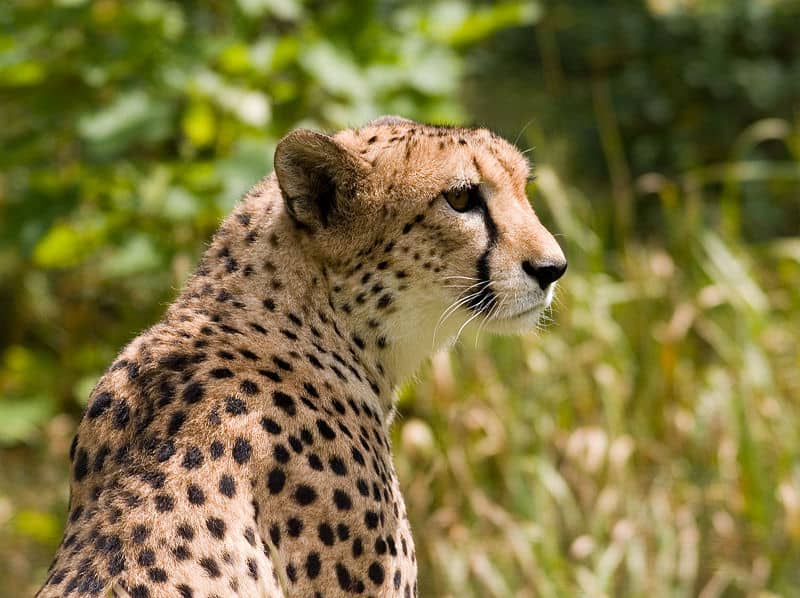
Cheetahs are the only wild or domesticated cat species that cannot roar. However, cheetahs do chirp, moan, hiss, and click as forms of communication.
When happy or content, cheetahs make a chirping noise similar to a bird call. Cubs will also chirp to let their mothers know they are okay. In addition to chirping, cheetahs purr like house cats when they are content but also purr when stressed or injured. Purring is a way for cheetahs to self-soothe and calm down.
When feeling threatened, a cheetah will moan, growl and hiss to scare off potential attackers.
So, why can’t cheetahs roar? Scientists believe it’s because they lack the hyoid bone necessary for roaring. The hyoid is a neck bone shaped like a horseshoe that helps support the tongue and vocal cords.
2. Cheetahs are sometimes raised with Puppies to ease their Anxiety
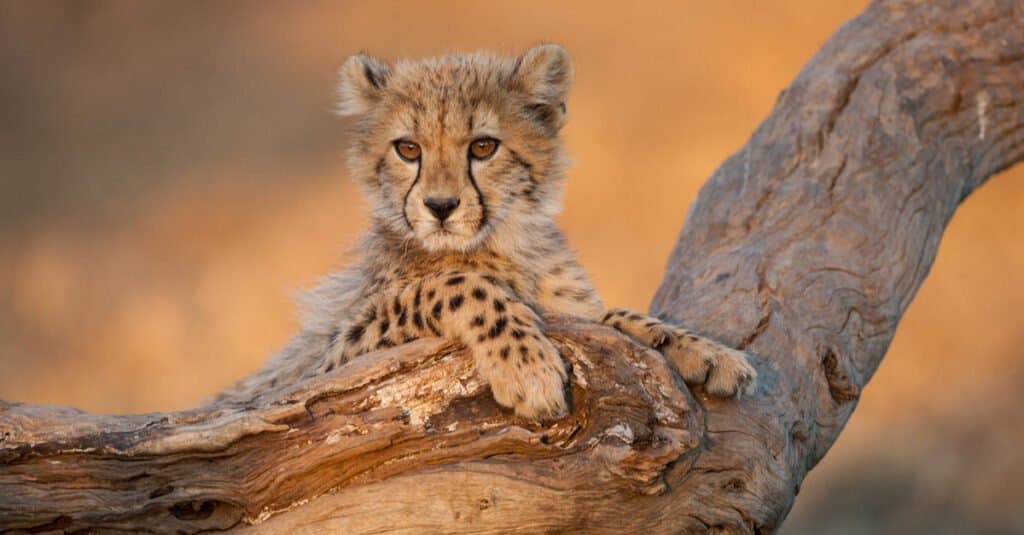
Stu Porter/Shutterstock.com
In the wild, cheetahs are shy and anxious creatures. For this reason, when raised in captivity, cheetah cubs are sometimes socialized with puppies. This socialization helps the cheetahs become more comfortable around humans and other animals.
Another widespread practice is using emotional support dogs to help cheetahs stay calm. These trained dogs give the cheetahs companionship and a sense of security, helping to reduce their stress levels. These dogs sometimes even help young cheetahs learn how to hunt.
While cheetahs constantly look for predators in the wild, they can relax a little more in zoo settings when they have a furry friend.
3. Cheetahs don’t Need to Drink Water Everyday
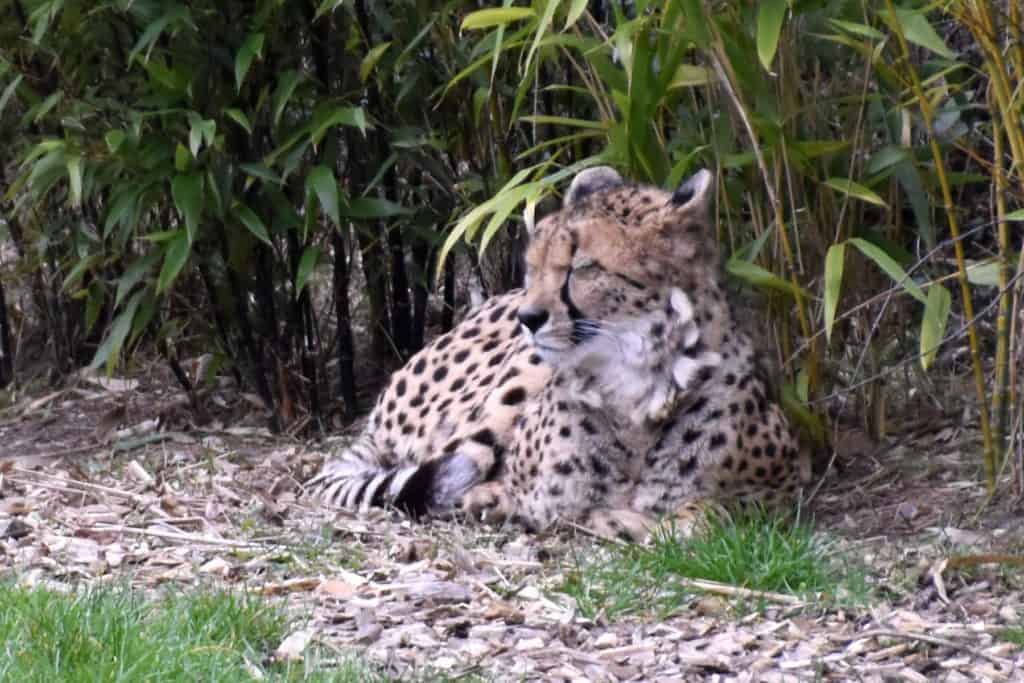
Millie Bond – Copyright A-Z Animals
The cheetah goes for 3 to 10 days without drinking water. Most of the water cheetahs need to survive comes from the body fluids of their prey.
Cheetahs hunt in short bursts to conserve energy and water stores and then rest for long periods. When they get thirsty, wild cheetahs drink from watering holes, rivers, and streams in their natural habitat.
Another reason cheetahs don’t drink as much water as other big cats is that they are used to desert conditions. Cheetahs are native to Iran and Africa, many of which live in the Sahara Desert. This massive desert is one of the hottest and dryest regions in the world. Cheetahs and other Sahara desert animals drink less water by conserving energy whenever possible to survive hot desert conditions.
4. Cheetahs have very few Genetic Differences

Stolz, Gary M – Public Domain by U.S. Fish and Wildlife Service
Here’s another incredible cheetah fact that might surprise you. Cheetahs have very little genetic diversity. In simple terms, there isn’t much difference between the genetic makeup of one cheetah and the next.
Over 10,000 years ago, North American and European cheetahs were close to extinction. During a period where their populations drastically reduced (called a “bottleneck event”), cheetahs preserved their species through inbreeding. As a result, new cheetahs had similar genetics. And their immune systems adapted to recognize other cheetahs as very close to clones.
Their low genetic diversity makes cheetahs great donors of organs and skin grafts for other cheetahs. However, some scientists argue that this adaptation also makes cheetahs more vulnerable to disease.
5. Cheetah Cubs look a bit like Honey Badgers
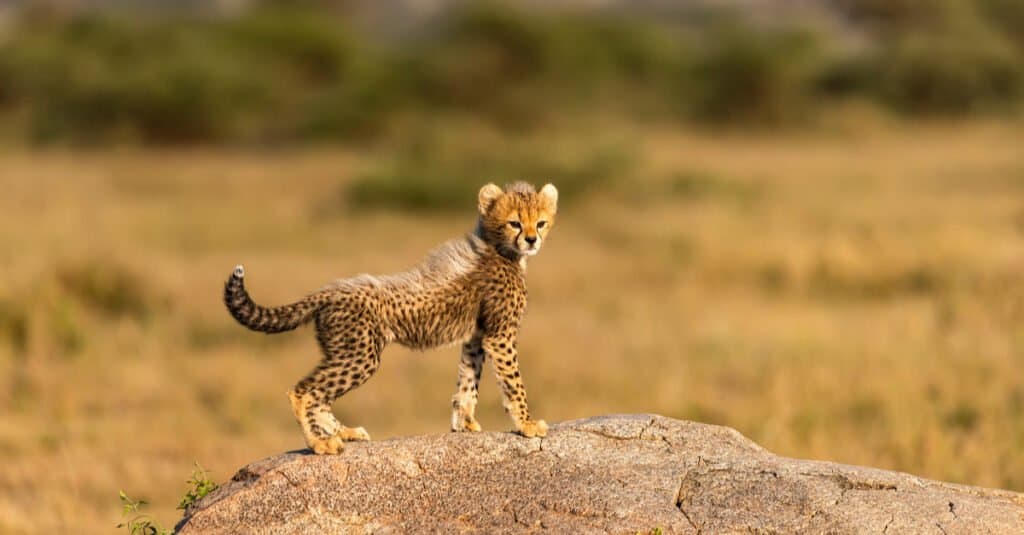
Danita Delimont/Shutterstock.com
Baby cheetahs have long, shaggy hair along their spine called a mantle. Their long mantle helps keep them warm in chilly weather and provides camouflage when running through tall grass. Many think this mantle makes cubs look like honey badgers to keep predators away.
Honey badgers have few predators, which is why looking like one would be a deterrent for hunters of cheetah cubs, like lions and leopards.
Cheetah cubs are also born with dark spots on a light coat to help them blend in with their surroundings. Their long mantle hair disappears as they age, but their spotted coat remains.
6. Cheetahs accelerate up to 60 miles per hour in just Three seconds

JonathanC Photography/Shutterstock.com
The cheetah is a high-speed cat. It’s the fastest land animal on earth, able to accelerate up to 60 miles per hour in only three seconds. Not only that, cheetahs can maintain these high speeds for short bursts of up to 600 yards. Their significant strides, an average of 12 and 16 feet long, help them quickly cover a lot of ground. A cheetah running at full speed can have strides up to 22 feet long!
Cheetahs are fast because they need to be. In the wild, cheetahs hunt primarily medium-sized animals like gazelles, also fast runners. If a cheetah can’t catch its prey, it won’t eat and will eventually starve. So, being fast is a matter of life or death for these big cats. And they have evolved some amazing adaptations that help them reach speeds of up to 70 miles per hour.
Their long legs and large strides help them quickly cover a lot of ground. But it’s their unique physiology that allows them to accelerate swiftly.
Cheetahs have enlarged hearts and lungs, which give them the extra oxygen they need to sustain high speeds. Their limbs are also very flexible, which helps them run quickly and efficiently. Plus, cheetahs are the only cats that can not retract their claws. So their ever-present claws help cheetahs get a good grip on the ground when running at high speeds.
Did you know that the cheetah’s long tail also aids in running balance and quick turns? Cheetahs rely on their tails to support their speed and agility.
7. The Cheetah’s long Tail keeps it from Tipping over and going Off Course

Cat tails serve important purposes! Cheetah tails are used for balance while they run. Their tails help them stay on track and avoid obstacles while moving at speeds up to 70 mph. They also aid in steering. When the cheetah wants to turn, it simply uses its tail to help guide it in the desired direction.
In addition, the cheetah’s tail serves as a means of communication with other cheetahs. For example, their tail movement signals when the cheetah is happy, scared, or angry.
Cheetahs also use their black-tipped tails to keep track of their cubs. If a cub strays too far from the group, the mother cheetah will wag her recognizable tail to summon the cub back.
Without its tail, the cheetah would be significantly disadvantaged in the wild.
8. Cheetahs aren’t Night Owls
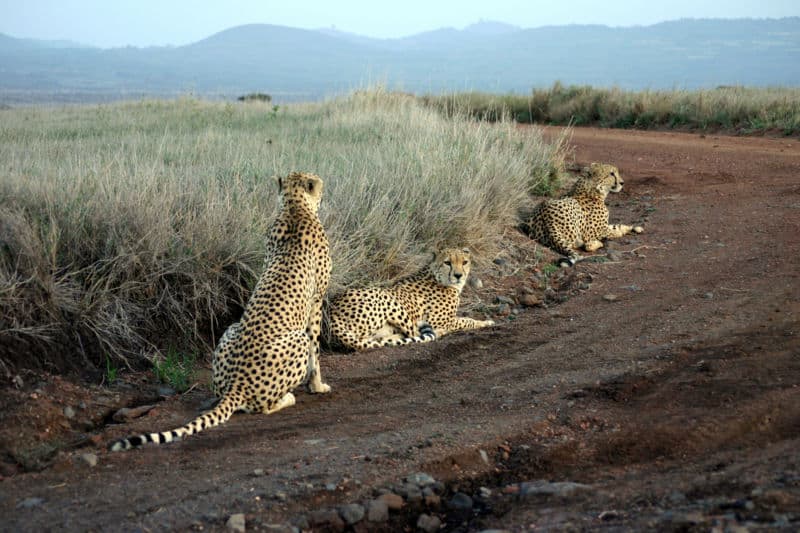
Another incredible cheetah fact is that it isn’t nocturnal. Unlike other predators, cheetahs don’t do their hunting under the cloak of darkness. Cheetahs are diurnal predators, which means they hunt during the day.
There are a few reasons why cheetahs prefer daylight hunting. For one, cheetahs rely on their vision to help them take down prey. They spot potential meals far away and then use their incredible speed to close in for the kill.
Another reason cheetahs hunt during the day is because it decreases the chance of their food getting stolen by nocturnal predators. A single adult cheetah can consume about 22 pounds of meat in one sitting. So, it’s understandable that they protect every ounce of their kill! The stress of protecting their food is also one reason cheetahs are so anxious.
Did you know that the cheetah’s facial markings make them better hunters? The dark markings around their eyes help reflect the sunlight and reduce glare, making it easier for them to see their prey.
9. A Cheetah kills its Prey by Suffocating it
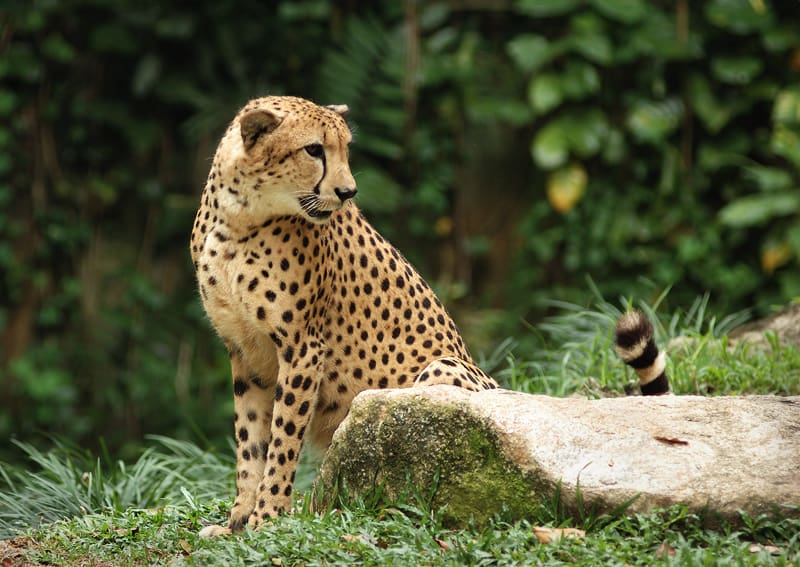
When a cheetah hunts, it goes for the throat. It kills its prey by biting down on the neck and cutting off the air supply. The cheetah then suffocates the prey while holding it down with its body weight. This method of killing is usually quick and efficient. It allows the cheetah to take down its target with little effort.
The cheetah is a carnivore that eats mainly medium-sized animals like springbok, impala, and gazelle. However, it also hunts the young of larger animals like oryx and sable. In addition, cheetahs eat smaller prey like rabbits and rodents.
10. Cheetahs are the most Endangered Wild Cat in Africa
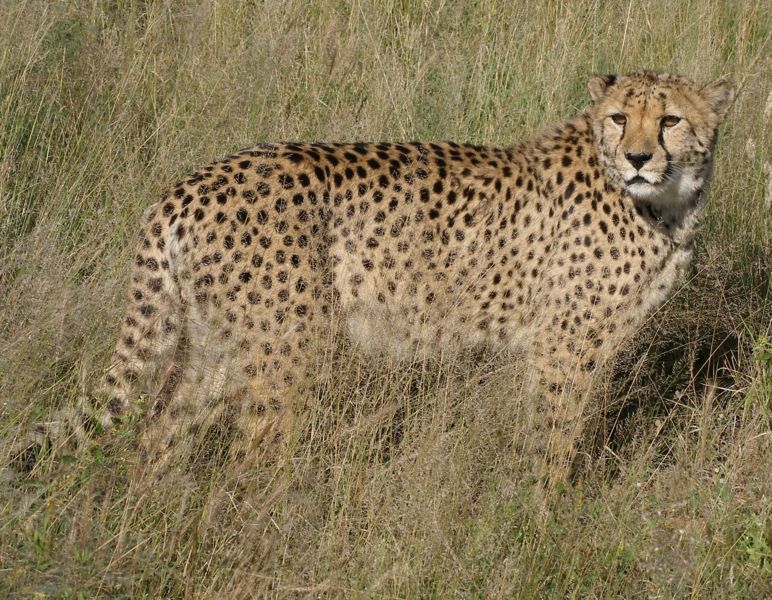
The International Union for the Conservation of Nature (IUCN) labels the cheetah as a “vulnerable” species but not yet endangered. However, the cheetah is a critically endangered animal in Africa. Their numbers are decreasing rapidly in Africa for various reasons, including habitat loss, human-wildlife conflict, and illegal wildlife trade.
Habitat loss is a big reason why cheetahs could eventually become extinct. These big cats need large expanses of land to roam and hunt. However, as human populations have exploded in Africa, cheetah habitat has declined. Farmers also kill cheetahs when they view them as a threat to their livestock.
Human-wildlife conflict is another reason for the decline in cheetah populations. As humans have moved into areas where cheetahs live, there’s more contact between the two species. Unfortunately, this situation often leads to conflict, resulting in cheetah deaths by humans who view them as a threat.
The illegal wildlife trade is a tragic problem for cheetahs. They are often captured and sold to zoos or private collectors. This practice further reduces the already small population of cheetahs in the wild. Less than 8,000 cheetahs remain worldwide. This number is far less than the 100,000+ cheetahs that roamed the continent 100 years ago.
How Trained Dogs help Cheetahs and Livestock Survive
When farmers in Namibia, Africa, lose livestock to predators, they often retaliate by killing the offender. Unfortunately, these kills put already endangered species like the cheetah at further risk. However, new guard dog programs are helping to protect both livestock and wild cheetahs.
A well-trained dog can intimidate a cheetah and chase it away without injuring it. A guard dog protects the farmer’s livestock and helps keep cheetahs safe from retaliation.
In addition to scaring away predators, guard dogs can serve as early warning systems. They bark at the first sign of trouble, alerting the farmer to potential danger. This action allows the farmer to take preventive measures, such as bringing livestock inside a fenced area, before any animals are harmed.
The success of guard dog programs depends on the cooperation of farmers. In some cases, farmers are reluctant to participate because they worry that the dogs will be a nuisance or attack livestock. However, guard dogs are a valuable asset when properly trained and managed. With the support of conservation groups, guard dog programs have the potential to benefit both people and wildlife.
Cheetahs are Incredible Animals!
From their long strides to their anxious personalities, cheetahs are intriguing mammals. For example, we learned that they’re the only big cat that doesn’t roar and, unlike many other predators, they hunt during daylight hours. These and other adaptations make cheetahs unique and exciting wild cats! Were there any of these 10 incredible cheetah facts you didn’t already know? Which ones are your favorites? If you love cheetah facts, check out our article about the top deadliest cats!
The post 10 Incredible Cheetah Facts appeared first on AZ Animals.
from Animal News, Facts, Rankings, and More! - AZ Animals https://ift.tt/DXohAxe